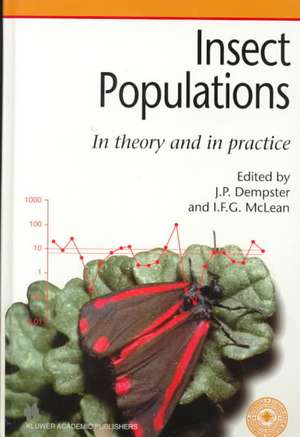Insect Populations: In Theory and in Practice
Editat de Jack Dempster, Ian McLeanen Limba Engleză Hardback – 31 dec 1998
Preț: 595.36 lei
Preț vechi: 700.42 lei
-15% Nou
Puncte Express: 893
Preț estimativ în valută:
113.94€ • 123.72$ • 95.71£
113.94€ • 123.72$ • 95.71£
Carte tipărită la comandă
Livrare economică 23 aprilie-07 mai
Preluare comenzi: 021 569.72.76
Specificații
ISBN-13: 9780412832604
ISBN-10: 0412832607
Pagini: 512
Dimensiuni: 160 x 240 x 32 mm
Greutate: 0.89 kg
Editura: Kluwer Academic Publishers
Locul publicării:Dordrecht, Netherlands
ISBN-10: 0412832607
Pagini: 512
Dimensiuni: 160 x 240 x 32 mm
Greutate: 0.89 kg
Editura: Kluwer Academic Publishers
Locul publicării:Dordrecht, Netherlands
Public țintă
ResearchCuprins
Preface. Contributors. Introduction. Definition of terms. Part 1: 1. Spatial structure and dynamics of insect populations; I. Hanski. 2. The regulation of populations by density-dependent processes; M.P. Hassell. 3. The role of density-independent processes in the stabilization of insect populations; P.J. den Boer. 4. Resource limitation of populations and ceiling models; J.P. Dempster. 5. The problems associated with the identification of density dependence in population data; P. Rothery. 6. Host-parasitoid dynamics; H.C.J. Godfray, C.B. Müller. 7. Biological control of insects: implications for theory in population ecology; W.W. Murdoch, C.J. Briggs, T.R. Collier. 8. The effects of qualitative changes of individuals in the population dynamics of insects; S.R. Leather, C.S. Awmack. Part 2: 9. Population dynamics of aphids; A.F.G. Dixon, P. Kindlmann. 10. The population dynamics of Tephritidae that inhabit flower-heads; N.A. Straw. 11. Population dynamics of the genus Maculinea (Lepidoptera: Lycaenidae); J.A. Thomas, R.T. Clarke, G.W. Elmes, M.E. Hochberg. 12. The dynamics of a herbivore-plant interaction, the cinnabar moth and ragwort; E. van der Meijden, R.M. Nisbet, M.J. Crawley. 13. The population dynamics of Operophthera brumata (Lepidoptera: Geometridae); J. Roland. 14. Population ecology of a gall-inducing sawfly, Euura lasiolepis, and relatives; P.W. Price, T.P. Craig, M.D. Hunter. 15. The population ecology of Trichochermes walkeri; I.F.G. McLean. 16. Bottom-up population regulation of a herbivorous lady beetle: an evolutionary perspective; T. Ohgushi. 17. The population ecology of Megaloprepus coerulatus and its effect on species assemblages in water-filled tree holes; O.M. Fincke. Concluding remarks. References. Species Index. Subject Index.
Recenzii
`...I would recommend the book not only for all the researchers in insect population ecology, but also as excellent reading for graduate seminars in (insect) population ecology, and as an excellent basis for discussion groups.' European Journal of Entomology, 97 (2000) `This uge package of knowledge must surely be read throughly more than once in order to digest everything. On the other hand, every reader can pick the articles that they find most interesting. I can warmly recommend the book as a basic textbook for university students as well as to professors and other lectures and all scientists dealing with these topics.' Entomologica Fennica, Vol.12
